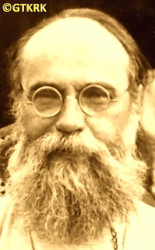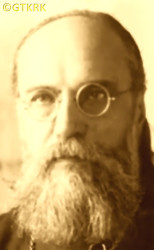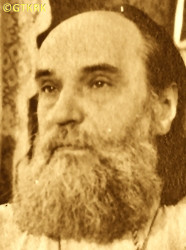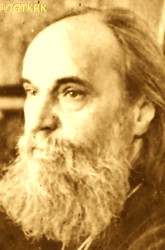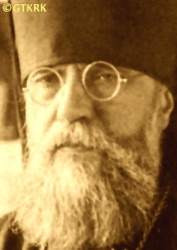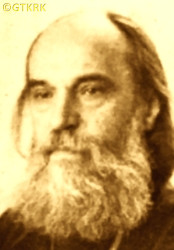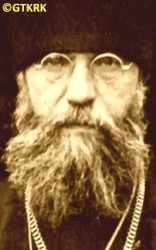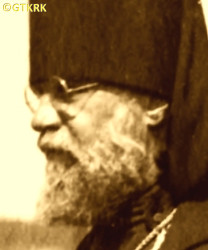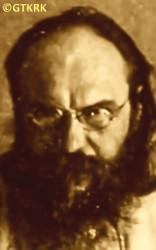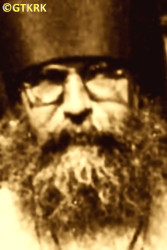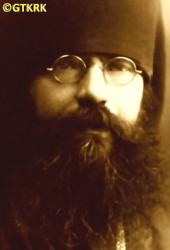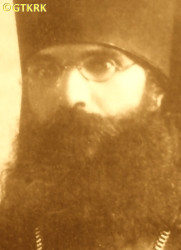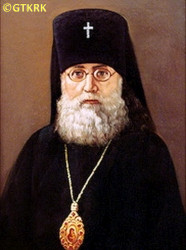Roman Catholic
St Sigismund parish
05-507 Słomczyn
85 Wiślana Str.
Konstancin deanery
Warsaw archdiocese, Poland
full list:
displayClick to display full list

searchClick to search full list by categories
wyświetlKliknij by wyświetlić pełną listę po polsku

szukajKliknij by przeszukać listę wg kategorii po polsku

Martyrology of the clergy — Poland
XX century (1914 – 1989)
personal data
surname
MARCENKO
surname
versions/aliases
MARCZENKO
forename(s)
Alexander (pl. Aleksander)
religious forename(s)
Anthony (pl. Antoni)

function
archbishop
creed
Eastern Orthodox Church ORmore on
en.wikipedia.org
[access: 2014.09.21]
diocese / province
Tula‐Belyov OR eparchymore on
drevo-info.ru
[access: 2020.09.24]
Oryol‐Bryansk OR eparchymore on
drevo-info.ru
[access: 2020.09.24]
Kirovohrad‐Mykolaiv OR eparchy (Ukrainian Autonomous Orthodox Churchmore on
drevo-info.ru
[access: 2023.07.16]
Kherson and Odessa OR eparchy (Ukrainian Autonomous Orthodox Church)more on
ru.wikipedia.org
[access: 2020.09.24]
Volyn‐Lutsk OR eparchymore on
ru.wikipedia.org
[access: 2023.07.16]
Grodno‐Novogrod OR eparchy (Polish Autocephalous Orthodox Church)more on
drevo-info.ru
[access: 2020.09.24]
Pińsk‐Polesia OR eparchy (Polish Autocephalous Orthodox Church PAOC)more on
pl.wikipedia.org
[access: 2021.08.20]
Warsaw‐Chełm OR eparchy (Polish Autocephalous Orthodox Church PAOC)
Vilnius OR eparchymore on
ru.wikipedia.org
[access: 2020.09.24]
academic distinctions
Sacred Orthodox Theology Candidate
date and place
of death
19.12.1954

ITL OzerLagGuLAG slave labour camp network
today: Tayshet, Irkutsk oblast, Russia
more on
en.wikipedia.org
[access: 2020.04.04]
details of death
From 1917, after the Bolsheviks seized power in Russia, the chaplain of the „White” Volunteer Army (Armed Forces of Southern Russia) fighting against them under the command of General Anton Denikin. However, already in 05.1919 returned to the south and again became the chaplain and dean of the cavalry corps of the Armed Forces of Southern Russia. Prob. took part in the unsuccessful march on Moscow, which began on 03.07.1919. After the defeat in the war with the Bolsheviks, evacuated with the army of General Wrangel, first prob. to the Crimea, and from there in 1920 to Serbia.
In 1922, after Polish victory in Polish–Russian war of 1919‐1921, returned to Poland.
In 11.1926 released from duties in the wake of attempt to make theological schools Ukrainian.
In 03.1931 made an oath to Polish State.
In 1940, after German and Russian attack in 09.1939 of Poland and start of World War II, after start of Russian occupation, made a penance and was readmitted into Russian Orthodox church.
After German attack on 22.06.1941 of their erstwhile ally, Russian, after start of German occupation, became bishop of Kherson–Odessa eparchy.
In 1944, escaping from Russian forces battling Germans went – through Romania – to Czechoslovakia.
There again reverted to Russian Orthodoxy.
Finally on 03.12.1951 arrested by the Russians.
On 01.04.1952 relieved from his Church duties.
On 05.06.1952 sentenced by Russian military court in Tula to 25 years of slave labour in Russian concentration camps Gulag.
Sent to ITL OzerLag concentration camp, to Tayshet.
There perished.
cause of death
extermination
perpetrators
Russians
sites and events
ITL OzerLagClick to display the description, GulagClick to display the description, Ribbentrop‐MolotovClick to display the description, Polish‐Russian war of 1919‐1921Click to display the description
date and place
of birth
12.03.1887

Odessatoday: Odessa urban hrom., Odessa rai., Odessa obl., Ukraine
more on
en.wikipedia.org
[access: 2022.02.04]
parents
MARCENKO Francis
🞲 ?, ? — 🕆 1889, ?

SAWICKA Sophia
🞲 ?, ? — 🕆 ?, ?
religious vows
20.07.1912 (permanent)
presbyter (holy orders)
ordination
06.12.1913

positions held
19.07.1946 – 01.04.1952
bishop — Tulatoday: Tula city reg., Tula oblast, Russia
more on
en.wikipedia.org
[access: 2021.04.02] ⋄ Russian Orthodox Church ⋄ Tula‐Belyov OR eparchy — dismissed from office after being arrested by the criminal Russian organization MGB; earlier, on 22.02.1950, distinguished by the right to wear a cross on a klobuk (monastic headgear)
17.01.1946 – 19.07.1946
bishop — Oryoltoday: Oryol oblast, Russia
more on
en.wikipedia.org
[access: 2021.09.17] ⋄ Russian Orthodox Church ⋄ Oryol‐Bryansk OR eparchy
19.10.1945 – 17.01.1946
rector — Karlovy Varytoday: Karlovy Vary dist., Karlovy Vary reg., Czechia
more on
en.wikipedia.org
[access: 2022.06.29] ⋄ St Peter and St Paul the Apostles OR church — acting („ad interim”)
1942 – 25.03.1944
bishop — Kirovohradtoday: Kropyvnytskyi, Kropyvnytsky city rai., Kirovohrad obl., Ukraine
more on
en.wikipedia.org
[access: 2021.09.17] ⋄ Ukrainian Autonomous Orthodox Church of the Moscow Patriarchate ⋄ Kirovohrad‐Mykolaiv OR eparchy — during the German occupation, in the face of the Russian offensive and the withdrawal of the Germans, evacuated first to Romania, then through Yugoslavia to Austria (then still part of Germany)
22.08.1941 – 1942
bishop — Ukrainian Autonomous Orthodox Church of the Moscow Patriarchate ⋄ Kherson‐Odessa OR eparchy — after German attack on 22.06.1941 on their erstwhile ally, the Russians, during the German occupation
28.03.1941
archbishop — Russian Orthodox Church — dignity conferment
28.10.1940 – 22.08.1941
auxiliary bishop — Kamin‐Kashyrskyitoday: Kamin‐Kashyrskyi urban hrom., Kamin‐Kashyrskyi rai., Volyn obl., Ukraine
more on
en.wikipedia.org
[access: 2020.11.27] ⋄ vicariate, Russian Orthodox Church ⋄ Volyn‐Lutsk OR eparchy — earlier, on 25.06.1940, after the start of World War II, during the Russian occupation, made a self–criticism, accepted penance and returned to the bosom of the Russian Orthodox Church
from 07.01.1937
auxiliary bishop — Kamin‐Kashyrskyitoday: Kamin‐Kashyrskyi urban hrom., Kamin‐Kashyrskyi rai., Volyn obl., Ukraine
more on
en.wikipedia.org
[access: 2020.11.27] ⋄ vicariate, Polish Autocephalous Orthodox Church PACP ⋄ Pinsk‐Polesia OR eparchy
c. 11.04.1935
hegumen–superior — Zhirovichitoday: Zhirovichi ssov., Slonim dist., Grodno reg., Belarus
more on
be.wikipedia.org
[access: 2022.11.09] ⋄ Polish Autocephalous Orthodox Church PACP ⋄ Assumption of the Blessed Virgin Mary OR monastery
07.05.1934 – 07.1937
bishop — Grodnotoday: Grodno dist., Grodno reg., Belarus
more on
en.wikipedia.org
[access: 2023.01.18] ⋄ Polish Autocephalous Orthodox Church PACP ⋄ Grodno‐Nowogródek OR eparchy — Lat. locum tenens (Eng. „holding reins”), acting („ad interim”); prob. from 05.12.1936 „retired”
from 15.04.1933
rector — Vilniustoday: Vilnius city dist., Vilnius Cou., Lithuania
more on
en.wikipedia.org
[access: 2022.01.06] ⋄ Orthodox Theological Seminary
from 03.1930
auxiliary bishop — Kamin‐Kashyrskyitoday: Kamin‐Kashyrskyi urban hrom., Kamin‐Kashyrskyi rai., Volyn obl., Ukraine
more on
en.wikipedia.org
[access: 2020.11.27] ⋄ vicariate, Polish Autocephalous Orthodox Church PACP ⋄ Pinsk‐Polesia OR eparchy
1928 – 24.05.1930
rector — Meltsitoday: Sokolyshche hrom., Stara Vyzhivka rai., Volyn obl., Ukraine
more on
uk.wikipedia.org
[access: 2023.07.16] ⋄ Polish Autocephalous Orthodox Church PACP ⋄ St Nicholas OR monastery
11.1926 – 1928
resident — Jabłecznatoday: Sławatycze gm., Biała Podlaska pov., Lublin voiv., Poland
more on
en.wikipedia.org
[access: 2021.12.18] ⋄ St Onuphrius OR monastery (stavropegial) — „retired”, relieved of his functions in connection with the promotion of „Ukrainization” of Orthodox theological schools
22.12.1925 – 11.1926
rector — Kremenetstoday: Kremenets urban hrom., Kremenets rai., Ternopil obl., Ukraine
more on
en.wikipedia.org
[access: 2020.10.18] ⋄ Orthodox Theological Seminary — also: hegumen–superior of the Epiphany monastery, a small community (seven monks in 1936), in one of the buildings of which was a seminary
c. 1925
hegumen–superior — Dermantoday: Derman Persha and Derman Druha, Mizoch hrom., Rivne rai., Rivne obl., Ukraine
more on
uk.wikipedia.org
[access: 2022.08.05] ⋄ Holy Trinity OR monastery — also: inspector of the Orthodox spiritual schools of the Volhynian eparchy
from 27.10.1924
rector — Vilniustoday: Vilnius city dist., Vilnius Cou., Lithuania
more on
en.wikipedia.org
[access: 2022.01.06] ⋄ Orthodox Theological Seminary — also: hegumen–superior of the Holy Trinity monastery, a small community in which the seminary was located
26.02.1923 – 01.09.1923
hegumen–superior — Jabłecznatoday: Sławatycze gm., Biała Podlaska pov., Lublin voiv., Poland
more on
en.wikipedia.org
[access: 2021.12.18] ⋄ St Onuphrius OR monastery (stavropegial)
from 25.02.1923
auxiliary bishop — Lublintoday: Lublin city pov., Lublin voiv., Poland
more on
en.wikipedia.org
[access: 2021.08.20] ⋄ vicariate, Russian Orthodox Church ⋄ Warsaw‐Chełm OR eparchy — the eparchy was de iure still dependent on the Russian Orthodox Church, although efforts were made for the autocephaly of the Polish Church; autocephaly materialised on 01.12.1924, when it was granted by the Patriarch of Constantinople, and the Polish Autocephalous Orthodox Church began de iure its existence
25.02.1923
Bishop — Warsawtoday: Warsaw city pov., Masovia voiv., Poland
more on
en.wikipedia.org
[access: 2021.10.09] ⋄ Russian Orthodox Church ⋄ St Alexander Nevsky OR cathedral church — bishop's cheirotonia, i.e. ordination; nominated on 09.02.1923 by the Synod of the Orthodox Church in Poland
10.1922 – 02.1923
hegumen–superior — Vilniustoday: Vilnius city dist., Vilnius Cou., Lithuania
more on
en.wikipedia.org
[access: 2022.01.06] ⋄ Holy Spirit OR monastery (stavropegial) — also: administrator of the Vilnius Eparchy, chairman of the Consistory in Vilnius
08.1922 – 10.1922
rector — Warsawtoday: Warsaw city pov., Masovia voiv., Poland
more on
en.wikipedia.org
[access: 2021.10.09] ⋄ St Alexander Nevsky OR cathedral church — after arriving in 07.1922 in independent Poland; also: chairman of the Orthodox Consistory in Warsaw
1920 – 1922
resident — (Serbia territory)today: Serbia
more on
en.wikipedia.org
[access: 2023.07.16] — emigrant, after the defeat of the White forces in the civil war with the Bolsheviks
c. 05.1919 – 1920
chaplain — Volunteer Army, Armed Forces of South Russia (anti–bolshevik White movement) — chaplain and dean of the cavalry, nominated by the Provisional Church Higher Authority in Southeast Russia
03.1919 – c. 05.1919
hegumen–superior — Pinsktoday: Pinsk city dist., Brest reg., Belarus
more on
en.wikipedia.org
[access: 2022.07.16] ⋄ Epiphany of the Lord OR monastery (fraternal)
03.1919
Archimandrite, i.e. superior abbot — Russian Orthodox Church — dignity conferment
c. 12.1917 – c. 03.1919
chaplain — Volunteer Army, Armed Forces of South Russia (anti–bolshevik White movement)
21.09.1916 – 1917
lecturer — Stavropoltoday: Stavropol city reg., Stavropol Krai, Russia
more on
en.wikipedia.org
[access: 2023.07.16] ⋄ Orthodox Theological Seminary — also: dean of the monasteries of the Stavropol eparchy (till 1916 Stavropol–Ekaterinodar, from 1916 Caucasus–Stavropol)
19.10.1915 – 21.09.1916
deputy inspector — Stavropoltoday: Stavropol city reg., Stavropol Krai, Russia
more on
en.wikipedia.org
[access: 2023.07.16] ⋄ Orthodox Theological Seminary
1915
hermit — Sosnivkatoday: Sosnivka hrom., Hlukhiv rai., Sumy obl., Ukraine
more on
ru.wikipedia.org
[access: 2023.07.16] ⋄ OR stavropegial Hermitage (Glinsk)
02.1914 – 1915
representative — Urmiaalso: Orumiyeh
today: Urmia cou., West Azerbaijan prov., Iran
more on
en.wikipedia.org
[access: 2023.07.16] ⋄ Russian Orthodox Church mission
06.12.1913
hieromonk — Russian Orthodox Church — priesthood cheirotonia, i.e. ordination
21.07.1912
hierodeacon — Kalugatoday: Kaluga city reg., Kaluga oblast, Russia
more on
en.wikipedia.org
[access: 2020.09.24] ⋄ Russian Orthodox Church — diaconate cheirotonia, i.e. ordination, preceded by the adoption of the tonsure and perpetual monastic vows on 20.07.1912
1910 – 1914
student — Sankt Petersburgtoday: Saint Petersburg city, Russia
more on
en.wikipedia.org
[access: 2020.07.31] ⋄ philosophy and theology, Orthodox Theological Academy — postgraduate specialised studies crowned with Sacred Orthodox Theology Candidate's degree
till 1910
student — Odessatoday: Odessa urban hrom., Odessa rai., Odessa obl., Ukraine
more on
en.wikipedia.org
[access: 2022.02.04] ⋄ philosophy and theology, Orthodox Theological Seminary
others related
in death
KULHAWIECClick to display biography Simeon, STEPANIUKClick to display biography George, GUDKOClick to display biography Basil (Bp Ambrose), NIKATOWClick to display biography Alex, OSTROUMOWClick to display biography Michael (Bp Seraphim), SAWICKIClick to display biography Yaroslav, SIENKIEWICZClick to display biography Alex, GAGALUKClick to display biography Anthony (Abp Onuphrius), STROCIUKClick to display biography Leontius, BLUMOWICZClick to display biography John, SZACHMUĆClick to display biography Roman (Fr Seraphim), PANASIEWICZClick to display biography Emilian, MIEDWIEDIUKClick to display biography Vladimir, SMOLENIECClick to display biography Alexander (Abp Arsenius), BORZAKOWSKIClick to display biography Alexander (Abp Agapit), DIERNOWClick to display biography Anatol (Abp Abramius)
sites and events
descriptions
ITL OzerLag: Russian Rus. Исправи́тельно‐Трудово́й Ла́герь (Eng. Corrective Labor Camp) ITL Rus. Озерный (Eng. Ozerniy) — concentration and slave forced labor camp (within the Gulag complex) — headquartered in the town of Taishet in the Irkutsk Oblast (in 1953‐1954 temporarily in Bratsk, in the same oblast). Founded on 07.12.1948 and until 1954 also functioning as the Rus. Особый лагерь (Eng. Special camp) GULAG No. 7. Prisoners among whom were many Poles slaved at the construction of the Baikal‐Amur railway — initially the Tayshet‐Bratsk section, and then from Bratsk to Ust'‐Kut (distance c. 700 km), at forest clearing and wood processing, and the related maintenance of industrial complexes, and the construction of a hydroelectric power plant , in quarries, in lime production, in agriculture and in the production of consumer goods, etc. At its peak — till the death on 05.03.1953 of Russian socialist leader, Joseph Stalin — c. 37,000 prisoners were held there: e.g. 31,881 (01.01.1950); 33,325 (01.01.1951); 37,093 (01.01.1952), one quarter of them were women; 31,225 (01.01.1953); 36,152 (01.02.1953); 29,347 (01.01.1954). Ceased to exist in 1960. (more on: old.memo.ruClick to attempt to display webpage
[access: 2024.04.08], gulagmuseum.orgClick to attempt to display webpage
[access: 2014.11.14])
Gulag: The acronym Gulag comes from the Rus. Главное управление исправительно‐трудовых лагерей и колоний (Eng. Main Board of Correctional Labor Camps). The network of Russian concentration camps for slave labor was formally established by the decision of the highest Russian authorities on 27.06.1929. Control was taken over by the OGPU, the predecessor of the genocidal NKVD (from 1934) and the MGB (from 1946). Individual gulags (camps) were often established in remote, sparsely populated areas, where industrial or transport facilities important for the Russian state were built. They were modeled on the first „great construction of communism”, the White Sea‐Baltic Canal (1931‐1932), and Naftali Frenkel, of Jewish origin, is considered the creator of the system of using forced slave labor within the Gulag. He went down in history as the author of the principle „We have to squeeze everything out of the prisoner in the first three months — then nothing is there for us”. He was to be the creator, according to Alexander Solzhenitsyn, of the so‐called „Boiler system”, i.e. the dependence of food rations on working out a certain percentage of the norm. The term ZEK — prisoner — i.e. Rus. заключенный‐каналоармец (Eng. canal soldier) — was coined in the ITL BelBaltLag managed by him, and was adopted to mean a prisoner in Russian slave labor camps. Up to 12 mln prisoners were held in Gulag camps at one time, i.e. c. 5% of Russia's population. In his book „The Gulag Archipelago”, Solzhenitsyn estimated that c. 60 mln people were killed in the Gulag until 1956. Formally dissolved on 20.01.1960. (more on: en.wikipedia.orgClick to attempt to display webpage
[access: 2024.04.08])
Ribbentrop‐Molotov: Genocidal Russian‐German alliance pact between Russian leader Joseph Stalin and German leader Adolf Hitler signed on 23.08.1939 in Moscow by respective foreign ministers, Mr. Vyacheslav Molotov for Russia and Joachim von Ribbentrop for Germany. The pact sanctioned and was the direct cause of joint Russian and German invasion of Poland and the outbreak of the World War II in 09.1939. In a political sense, the pact was an attempt to restore the status quo ante before 1914, with one exception, namely the „commercial” exchange of the so‐called „Kingdom of Poland”, which in 1914 was part of the Russian Empire, fore Eastern Galicia (today's western Ukraine), in 1914 belonging to the Austro‐Hungarian Empire. Galicia, including Lviv, was to be taken over by the Russians, the „Kingdom of Poland” — under the name of the General Governorate — Germany. The resultant „war was one of the greatest calamities and dramas of humanity in history, for two atheistic and anti‐Christian ideologies — national and international socialism — rejected God and His fifth Decalogue commandment: Thou shall not kill!” (Abp Stanislav Gądecki, 01.09.2019). The decisions taken — backed up by the betrayal of the formal allies of Poland, France and Germany, which on 12.09.1939, at a joint conference in Abbeville, decided not to provide aid to attacked Poland and not to take military action against Germany (a clear breach of treaty obligations with Poland) — were on 28.09.1939 slightly altered and made more precise when a treaty on „German‐Russian boundaries and friendship” was agreed by the same murderous signatories. One of its findings was establishment of spheres of influence in Central and Eastern Europe and in consequence IV partition of Poland. In one of its secret annexes agreed, that: „the Signatories will not tolerate on its respective territories any Polish propaganda that affects the territory of the other Side. On their respective territories they will suppress all such propaganda and inform each other of the measures taken to accomplish it”. The agreements resulted in a series of meeting between two genocidal organization representing both sides — German Gestapo and Russian NKVD when coordination of efforts to exterminate Polish intelligentsia and Polish leading classes (in Germany called «Intelligenzaktion», in Russia took the form of Katyń massacres) where discussed. Resulted in deaths of hundreds of thousands of Polish intelligentsia, including thousands of priests presented here, and tens of millions of ordinary people,. The results of this Russian‐German pact lasted till 1989 and are still in evidence even today. (more on: en.wikipedia.orgClick to attempt to display webpage
[access: 2015.09.30])
Polish‐Russian war of 1919‐1921: War for independence of Poland and its borders. Poland regained independence in 1918 but had to fight for its borders with former imperial powers, in particular Russia. Russia planned to incite Bolshevik‐like revolutions in the Western Europe and thus invaded Poland. Russian invaders were defeated in 08.1920 in a battle called Warsaw battle („Vistula river miracle”, one of the 10 most important battles in history, according to some historians). Thanks to this victory Poland recaptured part of the lands lost during partitions of Poland in XVIII century, and Europe was saved from the genocidal Communism. (more on: en.wikipedia.orgClick to attempt to display webpage
[access: 2014.12.20])
sources
personal:
pl.wikipedia.orgClick to attempt to display webpage
[access: 2020.09.24], drevo-info.ruClick to attempt to display webpage
[access: 2020.09.24], www.youtube.comClick to attempt to display webpage
[access: 2021.12.19], www.pstbi.ccas.ruClick to attempt to display webpage
[access: 2020.09.24]
bibliographical:
„Hierachy, clergy and employees of the Orthodox Church in the 19th‐21st centuries within the borders of the Second Polish Republic and post–war Poland”, Fr Gregory Sosna, M. Antonine Troc-Sosna, Warsaw–Bielsk Podlaski 2017
original images:
nne.ruClick to attempt to display webpage
[access: 2020.09.24], www.youtube.comClick to attempt to display webpage
[access: 2021.12.19], nne.ruClick to attempt to display webpage
[access: 2020.09.24], nne.ruClick to attempt to display webpage
[access: 2020.09.24], www.youtube.comClick to attempt to display webpage
[access: 2021.12.19], www.youtube.comClick to attempt to display webpage
[access: 2021.12.19], www.youtube.comClick to attempt to display webpage
[access: 2021.12.19], www.youtube.comClick to attempt to display webpage
[access: 2021.12.19], www.youtube.comClick to attempt to display webpage
[access: 2021.12.19], www.youtube.comClick to attempt to display webpage
[access: 2021.12.19], www.youtube.comClick to attempt to display webpage
[access: 2021.12.19], commons.wikimedia.orgClick to attempt to display webpage
[access: 2020.09.24], drevo-info.ruClick to attempt to display webpage
[access: 2020.09.24]
LETTER to CUSTODIAN/ADMINISTRATOR
If you have an Email client on your communicator/computer — such as Mozilla Thunderbird, Windows Mail or Microsoft Outlook, described at WikipediaPatrz:
en.wikipedia.org, among others — try the link below, please:
LETTER to CUSTODIAN/ADMINISTRATORClick and try to call your own Email client
If however you do not run such a client or the above link is not active please send an email to the Custodian/Administrator using your account — in your customary email/correspondence engine — at the following address:

giving the following as the subject:
MARTYROLOGY: MARCENKO Alexander
To return to the biography press below:
 Click to return to biography
Click to return to biography








